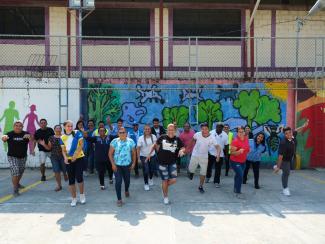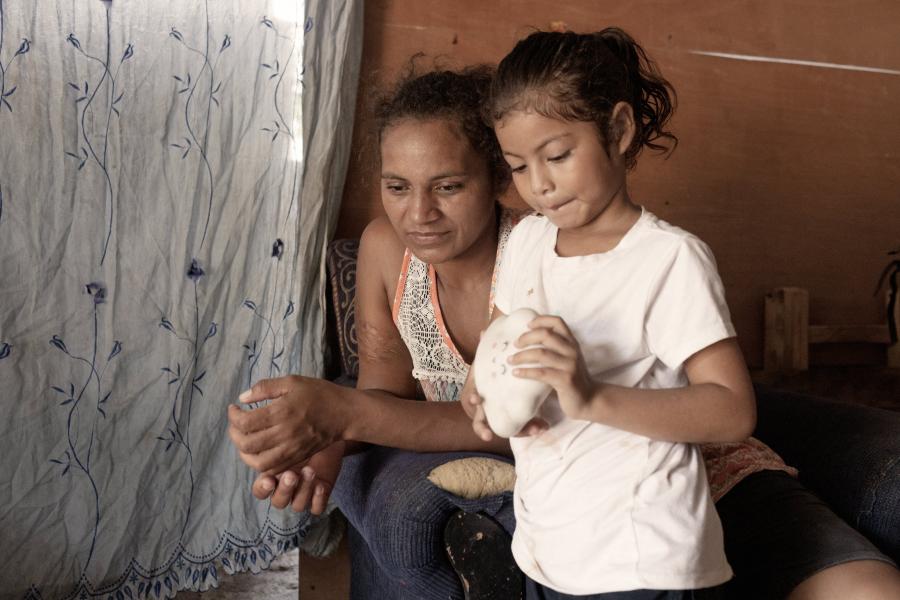2023 situation overview
In 2023, the National Migration Institute of Honduras recorded the irregular entry of 541,300 people arriving in mixed movements of refugees and migrants, including people who had trekked northwards through Panama’s Darien jungle, and Nicaraguans and individuals from Cuba, Haiti, and various other nationalities who arrived through Nicaragua. UNHCR Honduras significantly stepped up its response to the unprecedented number of people in mixed movements, marking a pivotal year in providing protection and assistance amidst overwhelmed reception capacities. The operation successfully advocated for the extension of the migration amnesty, which exempts people from an administrative fine of about $240 after irregular entry into the country. UNHCR supported its partner, the National Institute of Migration (INM), in establishing the first Comprehensive Assistance Centre in Danlí, an entry hotspot on the south-eastern border, directly assisting over 36,500 people on the move. UNHCR's concerted efforts included strengthening protection border monitoring, using high-frequency surveys to better understand the needs and profiles of people on the move, and reaching more than 137,000 people with essential protection information through mobile information services.
In Guatemala, people in mixed movements stayed longer than in previous years to await remittances and work informally to finance their travel. This increased tension with authorities and host communities and impacted the assistance of partners and the government as shelters were getting overcrowded and the capacity to respond both from partners and the Government is becoming very limited. UNHCR’s response to mixed movements consisted in facilitating access to territory and asylum, as well as legal orientation. It has also coordinated assistance with other agencies and local actors. In 2023, the number of people transiting El Salvador to reach Guatemala increased. A small number of them sought asylum in the country.
318,600 people were internally displaced in the sub-region, having fled from their homes due to gender-based violence (including femicides), human rights violations, extorsion, forced recruitment of children and youth, and homicides, including killings of land and human rights defenders. The plight of indigenous rights defenders and the rates of violence against them also remained a contributor to forced displacement.
In the United States of America, almost one in every 10 new asylum applications was lodged by nationals of Honduras (4.2%), Guatemala (3.6%), and El Salvador (2.1%) in 2023. Worldwide, there were over 711,400 asylum-seekers and refugees from El Salvador, Guatemala and Honduras.
The adoption of the Los Angeles Declaration on Migration and Protection in June 2022 highlighted the need for a better-coordinated and collaborative approach to address human mobility in the Americas.
UNHCR supported local authorities and worked in partnership with IOM, UNICEF and others, to provide protection and humanitarian assistance. In Guatemala, five Centres for Migrants and Refugees (CAPMiR) located in border areas and high transit routes served as key protection spaces to identify persons with international protection needs, provide humanitarian assistance such as water, sanitation, and hygiene, psychosocial assistance and counselling, essential first aid, and information on access to asylum and protection services in Guatemala.
In El Salvador, Guatemala and Honduras, UNHCR advocated in favour of a protection-centred response and providing people with information on access to asylum and protection services.
Through its leadership of key clusters, UNHCR also worked to coordinate efforts undertaken by national and local governments, international organizations, civil society, community organizations, and displaced populations.
In Honduras, UNHCR delivered technical support for the implementation of the protection law for internally displaced people. Additionally, UNHCR provided recommendations on fortifying the legal framework to address the forced recruitment of children by criminal groups, and supported the establishment of a registry of abandoned property, in collaboration with the Property Institute.
In El Salvador, UNHCR consolidated the expansion of its outreach capacity with an established presence in four regions of the country in the “Support Spaces”. In the “Support Spaces” multiple actors including the Government and UNHCR offered services and assistance to over 5,000 forcibly displaced people and host communities. Survivors of gender-based violence received specialized remote assistance and guidance nationwide through a helpline run by the Government and supported by UNHCR.
UNHCR also supported livelihood initiatives and access to employment, including soft skills training and job certification, seed capital and entrepreneurship.
In El Salvador, the “My First Job” programme, a UNHCR and Ministry of Labour joint initiative, promoted access to employment for youth who were forcibly displaced or at risk of displacement. Between its inception in 2021 and the end of 2023, 698 young people had signed an employment contract and 1,207 had received training. In Honduras, UNHCR launched an innovative livelihood programme in collaboration with various organizations and 53 private sector companies to support the professional development of displaced youth through funded internships. The Secretariat of Labour and Social Security recognised the programme as a significant contribution to the Regional Comprehensive Protection and Solutions Framework (MIRPS) framework and plans to expand it in 2024.
In Mexico, UNHCR collaborated with 600 companies and local and national authorities to facilitate the integration of 37,000 refugees (including 7,700 in 2023 alone – 63% from Honduras, 11% from El Salvador and 5% from Guatemala), by relocating them from southern border areas to cities in central and northern Mexico where job opportunities are more abundant. Their employment is estimated to generate more than $10 million in annual tax revenue for Mexico.
From mid-2023, UNHCR and IOM supported Movilidad Segura (safe mobility), an initiative led by the United States of America to broaden resettlement opportunities and other lawful pathways. In its pilot phase in Colombia, Costa Rica, Ecuador and Guatemala, the initiative referred 13,859 individuals for resettlement, including 3,659 from Guatemala.
Through MIRPS and its Support Platform, governments continued implementing regional and national action plans to strengthen protection and solutions, including in countries of origin, host communities, transit countries and countries of destination.
As MIRPS member States, El Salvador, Guatemala and Honduras endorsed regional pledges presented at the 2023 Global Refugee Forum and participated in regional exchanges and initiatives to expand good practices on integration.
To deepen cooperation in support of the inclusion of forcibly displaced and stateless people in development programmes, and to reinforce efforts to analyse and address the root causes of forced displacement as an integral part of development projects, UNHCR strengthened strategic partnerships across the region with the World Bank, Inter-American Development Bank (IDB), Central American Development Bank and others. UNHCR partnered with the World Bank on studies to better understand the risks of gender-based violence experienced by women and girls in situations of displacement and mixed movements, and the barriers they face to access services along routes. UNHCR also provided protection expertise to the IDB’s work increasing labour market integration for returnees in the sub-region.
Despite generous donor support to the sub-region, UNHCR faced difficulties in meeting rising humanitarian needs in a context of increased mixed movements, violence, and the impacts of climate change.
In El Salvador, only those households at most risk received assistance in cash to cover basic needs, despite other eligible people requiring support. Also, employment and livelihoods programmes reached limited numbers of displaced people in need of livelihoods opportunities. UNHCR postponed the expansion of roving teams for mental health services until more funds are available.
Notably, the presence in remote or border areas to monitor mixed movements was intermittent because of limited resources. In Honduras for example, underfunding notably prevented a permanent presence in Danlí, an area particularly affected by the humanitarian crisis, therefore limiting support to crucial actors like the Secretariat of Human Rights for the implementation of the IDP law. This led to reduced protection and assistance for people in vulnerable situations, diminished socioeconomic inclusion efforts, and a hampered capacity to respond to emergencies and violence-induced displacements.
In Guatemala, UNHCR provided shelter solutions in several locations, but despite assisting hundreds of people every day, often faced challenges due to the large influx of people, with a scarcity of clothing, beds, food, infrastructure maintenance and translation services. Overcrowding of shelters generated additional protection risks.
Financial overview
More contributions information on previous years: Funding Update 2022 | Funding Update 2021
Hurricane-hit community in Honduras comes together to prepare for future climate disasters
By Gabriela Villeda Castillo and José Romero Vásquez in San Pedro Sula, Honduras
After 40 years living in Chamelecón, a low-income community near the Honduran city of San Pedro Sula, Susana*, 65, was no stranger to calamity. Three years after experiencing huge losses and displacement from Hurricanes Eta and Iota, the San Pedro Sula community is determined to be ready for the next disaster.
Read the story

